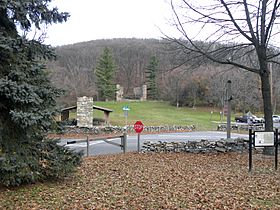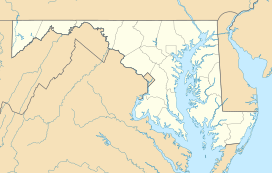Crampton's Gap facts for kids
Quick facts for kids Crampton's Gap |
|
|---|---|

Crampton's Gap looking from the south side (Gathland State Park) to the north
|
|
| Elevation | 928 feet (283 m) |
| Traversed by | Gapland Road |
| Location | Frederick County and Washington County, Maryland, United States |
| Range | South Mountain Blue Ridge Mountains |
| Coordinates | 39°25′N 77°38′W / 39.41°N 77.64°W |
Crampton's Gap, also known as Crampton Gap, is a special dip in the South Mountain range in Maryland. It's called a "wind gap" because it's a low point in a mountain ridge that was likely carved out by an ancient river.
This gap is about 928 feet (283 m) high. It connects two valleys: the Middletown Valley to the east, where Burkittsville is located, and the Pleasant Valley to the west, home to Gapland and Rohrersville.
Crampton's Gap is famous for two main reasons. It's the home of Gathland State Park, a unique historical park. More importantly, it was the site of a major battle during the American Civil War on September 14, 1862.
Contents
The Battle of Crampton's Gap
Crampton's Gap played a key role in the Maryland Campaign of the American Civil War. This was a time when the Confederate army, led by General Robert E. Lee, moved into Maryland.
Why Was This Battle Important?
The battle at Crampton's Gap happened on September 14, 1862. It was part of a larger plan by the Union army to stop the Confederates. The Union forces needed to break through the Confederate defenses on South Mountain.
General Lee had divided his army. He sent some troops to capture Harpers Ferry, a very important Union outpost. To protect these troops, he left a small force to guard the mountain passes, including Crampton's Gap.
Who Fought Here?
The Union army, led by Major General William B. Franklin, attacked the Confederate defenders at Crampton's Gap. The Confederates were outnumbered.
The fighting was fierce. The Union soldiers pushed hard to gain control of the gap. They wanted to open a path to help the Union troops trapped at Harpers Ferry.
What Was the Outcome?
After several hours of fighting, the Union forces managed to defeat the Confederates at Crampton's Gap. This victory allowed the Union army to move forward.
However, the Union's success at Crampton's Gap didn't happen fast enough. The Confederate troops at Harpers Ferry surrendered before help could arrive. Still, the battle at Crampton's Gap was an important Union victory. It helped set the stage for the much larger and bloodier Battle of Antietam just a few days later.
Gathland State Park: A Place of History
Today, Crampton's Gap is home to Gathland State Park. This park is not just a beautiful place; it's also a monument to history.
Who Created Gathland Park?
The park was created by George Alfred Townsend, a famous newspaper reporter from the Civil War. He bought land around Crampton's Gap after the war.
Townsend built a unique estate there. He created several stone monuments and arches to honor the journalists who covered the Civil War. He called his estate "Gathland," using his pen name, "Gath."
What Can You See There?
When you visit Gathland State Park, you can explore Townsend's historic structures. These include the impressive War Correspondents Arch. This arch is a memorial to the brave reporters who shared the stories of the war.
The park also offers walking trails and picnic areas. It's a great place to learn about history and enjoy nature. You can imagine the soldiers who fought there and the reporter who later honored their stories.


